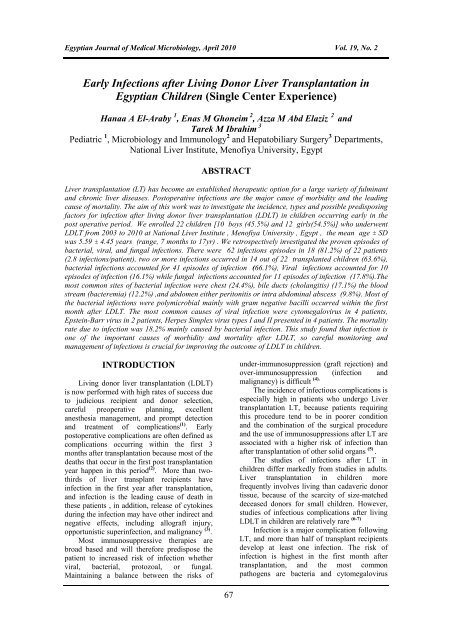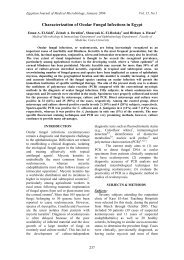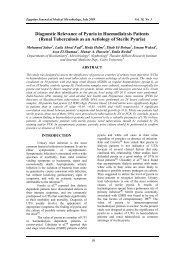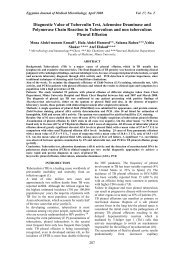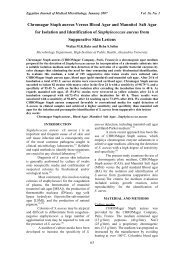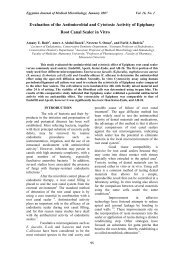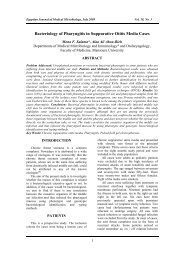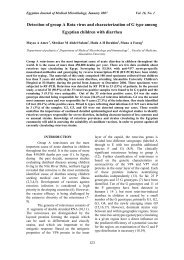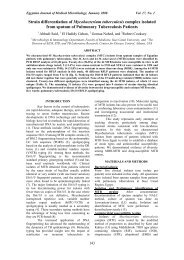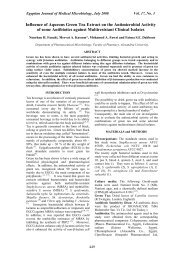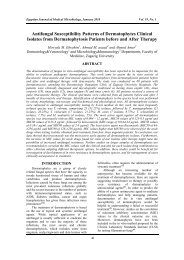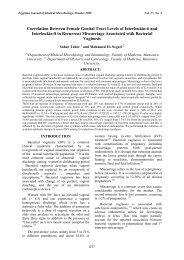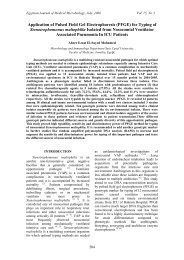Amal A. Wafy MD*, Kamal M. Hanna MD **, Ayman Salem MD ...
Amal A. Wafy MD*, Kamal M. Hanna MD **, Ayman Salem MD ...
Amal A. Wafy MD*, Kamal M. Hanna MD **, Ayman Salem MD ...
Create successful ePaper yourself
Turn your PDF publications into a flip-book with our unique Google optimized e-Paper software.
Egyptian Journal of Medical Microbiology, April 2010 Vol. 19, No. 2Early Infections after Living Donor Liver Transplantation inEgyptian Children (Single Center Experience)Hanaa A El-Araby 1 , Enas M Ghoneim 2 , Azza M Abd Elaziz 2 andTarek M Ibrahim 3Pediatric 1 , Microbiology and Immunology 2 and Hepatobiliary Surgery 3 Departments,National Liver Institute, Menofiya University, EgyptABSTRACTLiver transplantation (LT) has become an established therapeutic option for a large variety of fulminantand chronic liver diseases. Postoperative infections are the major cause of morbidity and the leadingcause of mortality. The aim of this work was to investigate the incidence, types and possible predisposingfactors for infection after living donor liver transplantation (LDLT) in children occurring early in thepost operative period. We enrolled 22 children [10 boys (45.5%) and 12 girls(54.5%)] who underwentLDLT from 2003 to 2010 at National Liver Institute , Menofiya University , Egypt , the mean age ± SDwas 5.59 ± 4.45 years (range, 7 months to 17yr) . We retrospectively investigated the proven episodes ofbacterial, viral, and fungal infections. There were 62 infections episodes in 18 (81.2%) of 22 patients(2.8 infections/patient), two or more infections occurred in 14 out of 22 transplanted children (63.6%),bacterial infections accounted for 41 episodes of infection (66.1%), Viral infections accounted for 10episodes of infection (16.1%) while fungal infections accounted for 11 episodes of infection (17.8%).Themost common sites of bacterial infection were chest (24.4%), bile ducts (cholangitis) (17.1%) the bloodstream (bacteremia) (12.2%) ,and abdomen either peritonitis or intra abdominal abscess (9.8%). Most ofthe bacterial infections were polymicrobial mainly with gram negative bacilli occurred within the firstmonth after LDLT. The most common causes of viral infection were cytomegalovirus in 4 patients,Epstein-Barr virus in 2 patients, Herpes Simplex virus types I and II presented in 4 patients. The mortalityrate due to infection was 18.2% mainly caused by bacterial infection. This study found that infection isone of the important causes of morbidity and mortality after LDLT, so careful monitoring andmanagement of infections is crucial for improving the outcome of LDLT in children.INTRODUCTIONLiving donor liver transplantation (LDLT)is now performed with high rates of success dueto judicious recipient and donor selection,careful preoperative planning, excellentanesthesia management, and prompt detectionand treatment of complications (1) . Earlypostoperative complications are often defined ascomplications occurring within the first 3months after transplantation because most of thedeaths that occur in the first post transplantationyear happen in this period (2) . More than twothirdsof liver transplant recipients haveinfection in the first year after transplantation,and infection is the leading cause of death inthese patients , in addition, release of cytokinesduring the infection may have other indirect andnegative effects, including allograft injury,opportunistic superinfection, and malignancy (3) .Most immunosuppressive therapies arebroad based and will therefore predispose thepatient to increased risk of infection whetherviral, bacterial, protozoal, or fungal.Maintaining a balance between the risks ofunder-immunosuppression (graft rejection) andover-immunosuppression (infection andmalignancy) is difficult (4).The incidence of infectious complications isespecially high in patients who undergo Livertransplantation LT, because patients requiringthis procedure tend to be in poorer conditionand the combination of the surgical procedureand the use of immunosuppressions after LT areassociated with a higher risk of infection thanafter transplantation of other solid organs (5) .The studies of infections after LT inchildren differ markedly from studies in adults.Liver transplantation in children morefrequently involves living than cadaveric donortissue, because of the scarcity of size-matcheddeceased donors for small children. However,studies of infectious complications after livingLDLT in children are relatively rare (6-7)Infection is a major complication followingLT, and more than half of transplant recipientsdevelop at least one infection. The risk ofinfection is highest in the first month aftertransplantation, and the most commonpathogens are bacteria and cytomegalovirus67
Egyptian Journal of Medical Microbiology, April 2010 Vol. 19, No. 2(CMV) .Bacterial infections usually arise fromthe abdomen , and are caused by aerobes (8) .The peak incidence of CMV infection islate in the first month and early in the secondmonth after transplantation. CMV syndromesinclude fever and neutropenia, hepatitis,pneumonitis, gut ulceration, and disseminatedinfection. Other significant problems areCandida intra abdominal infection, HerpesSimplex mucocutaneous infection or hepatitis,adenovirus hepatitis, and Pneumocystis cariniipneumonia (9) .Ideally LDLT is associated with theimprovement of graft and patient survivalbecause the condition of these patients is better,due to shorter waiting time, use of electivesurgery, and better graft viability due to shortischemic time especially if infection wascontrolled (10).Aim of work: The aim of this study was toinvestigate the incidence, types and possiblepredisposing factors for infection after livingdonor liver transplantation (LDLT) in childrenoccurring early in the post operative period .PATIENTS & METHODSThis study included 22 children [10 boys(45.5%) and 12 girls (54.5%)] who underwentLDLT from 2003 to 2010 in National LiverInstitute, Menofiya University, Egypt. Themean age±SD was 5.59±4.45 years (range, 7months to 17 yr).The underlying liver diseases that indicatedLDLT were biliary atresia in10 patients(45.5%), Budd Chiari syndrome in 3 patients(13.7%), Congenital hepatic fibrosis, Bylerdisease, and Chronic hepatitisC in 2 patients forevery disease (9.2%), Cryptogenic cirrhosis inone patient (4.5%). ,Hepatoblastoma in onepatient (4.5%)., and Hemangioma also in onepatient (4.5%).Patients and their donors were subjected tofull history taking, thorough clinicalexamination done by pediatric hepatologists,surgeons, intensivists, and anaesthesiologistsPreoperative data were collected from allpatients as associated medical diseases,gastrointestinal tract bleeding, abdominaloperations, infection, ascites andencephalopathy.Pre operative Laboratory investigations weredone to all patients and donors:• Complete blood count (CBC) using Sysmexautomated hematology analyzer, Japan.• Pre operative sepsis indicators as total anddifferential leucocytic count, fibrindegradation products (FDP) and D dimmersby latex agglutination test(Remes kit USA)and C- reactive protein using Integra 400autoanlyzer .• Liver, lipid, and renal profiles, bloodglucose, uric acid, and serum amylase,using Integra 400 autoanlyzer Rochediagnostics. Serum electrolyte using AVL9180 electrolyte analyzer Rochediagnostics.• Coagulation indicators (Prothrombin timePT, and concentration, activated partialthromboplastin time PTT, anti thrombin IIIAT III, and fibrinogen) using Thrombrel-Sfrom Behring Diagnostic Inc. Germany.• Tumour markers (carcinoembryonic antigenCEA, α-fetoprotein α FP, CA-19.9) UsingElecys 2010 Roche Diagnostics• Viral markers (serology for IgG and IgM)of the following viruses: Cytomegalovirus(CMV), Epstein Barr, Herpes simplex typeI and II, Varicella zoster, respiratorysyncitial, measles, mumps, rubella,influenza and HIV-1 were done by ELISAtechnique, by kit from Diapro diagnosticbioprobes, Italy. HCV antibodies by kitfrom Innogenetics, Ghent-Belgium. HBSantigen by kit from Sorin Biomedica Co,Spain. Candida antibodies were also doneusing ELISA technique, by (EnzymeVirotech Gmbtt).Imaging by abdominal ultrasonographyincluding Doppler scan on hepatic vessels,abdominal CT, chest X-ray and chest CT scanwere performed, ECG, echocardiography, Bloodgases analysis. Eye, dental, ear, nose and throatexaminations were done to exclude relatedseptic foci. Bowel decontamination byneomycin syrup 50mg/kg and plus miconazoledivided on 4 doses were started one day beforesurgery.Tacrolimus 0.05mg/kg on 9 a.m. and 9p.m., one day before transplant. Cephalosporineand penicilline start at 9 a.m. on the day oftransplant.Postoperative assessment on day one included:• Chest X-ray, abdominal ultrasonographyonce daily or after extubation.• Doppler US every 4-8 hours).• Cultures from drain, pharyngeal swab, urineand discharge.• Blood gases analysis.• Methyl prednisolone 1mg/kg once daily .Post operative laboratory tests (CBC, CRP,liver, coagulation and renal profiles, bloodglucose, serum electrolytes, uric acid, amylase,viral markers and Candida antibodies) were68
Egyptian Journal of Medical Microbiology, April 2010 Vol. 19, No. 2done by the same techniques discussed above,also detection the level of immunosuppressantdrug tacrolimus (FK506) in the blood usingIMX method . These tests were done twice dailyduring the intensive care unit (ICU) stay andonce daily during hospital stay in the ward.Patients were monitored till the end of the firstpostoperative month. Clinical suspicion ofinfection was considered when one or more ofthe following was present: fever, leucocytosis,neutrophils showing shift to the left, rise inCRP, chest X-ray findings suggestive ofpneumonitis, or positive culture from any bodyfluid.Post operative cultures• Different samples Cultures: The followingsamples were taken from each patientstwice weekly (sputum, urine, pus, throatswab, nasal swab, ascitic fluid, stools, andany other body fluids as biliary tube outputand drains) these samples were plated ontoblood, MacConkey, mannitol, salt agar andsabourd dexterose agar (oxoid, Basingstoke, England). Stool samples wereenriched first into selenite broth, then platedon MacConkey and S S agar. Inoculatedplates were incubated at 370C for 24 -48hours under aerobic and anaerobicconditions. The isolated colonies wereidentified by the standard microbiologicalmethods (11-12) .• Blood culture: blood samples were obtainedfrom each patient when infection wassuspected post LT. Five ml blood wasdispensed into aerobic culture (Tryptic-Soy- broth TSB) and anaerobic culurebottles (thioglycolate broth media) (Difco.Laboratories, Detroite, Michgan,,USA) (13) .The inoculated bottles were incubated at37C 0 for 3 weeks , they were examineddaily during the first week and every 2 daysduring the second week for appearance ofturbidity, hemolysis, signs of gasproduction or growth directly above theblood, with performance of subcultures onblood agar plates under aerobic andanaerobic conditions. The resultant colonieswere identified by the standardmicrobiological methods (11-12) .• Postoperative diagnosis of CMV infectionwas done by quantification of CMV DNAin plasma by PCR using COBASAMPLICOR Roche diagnostics which usethe biotinylated primers LC242C andLC383 to define a sequence of nucleotidelocated in the amino acid terminus of CMVDNA polymerase.• Postoperative prophylactic antibioticregimen included, cephalosporine andpenicilline intra venously then according tothe cultures and sensitivity tests. in additionto Intravenousl fluconazole (6 mg/kg) wereused as prophylaxis to prevent fungalinfections.Statistical Methods:Mean and standard deviation werecalculated for continuous variables whilefrequency and percent were calculated forcategorical variables to compare continuousvariables between 2 groups. T-test was used toestimate the probability of difference ifapplicable. Statistical computer soft warepackage SPSS 15.0 was used in the analysis.RESULTSThis study included 22 children [10 boys(45.5%) and 12 girls (54.5%)] who underwentLDLT from 2003 to 2010 in National LiverInstitute, Menofiya University Egypt. The meanage± SD was 5.59±4.45 years (range, 7 monthsto 17 yr).There were significant relations betweeninfection and preoperative symptoms (asencephalopathy, ascites, GIT bleeding), Graftbody weigh ratio( GRBW ratio ), FK605 leveland cold ischemic type as shown in ( table 1)and with serum creatinine level (table 2).Infection complicated 18 out of 22 transplantedchildren (81.8%) so the rate of infection in thecurrent study was 81.2%, There were 62infection episodes in 18 (81.2%) of 22 patients(2.8infections/patient), pure bacterial infectionwas in 4 patients (18.2%) ,two types of infection(either bacterial and viral in 3 patients, bacterialand fungal in 4 patients or viral and fungal inone patients) or more than two types (bacterial,viral and fungal in 6 patients) occurred in 14out of 22 transplanted children (63.6%).Bacterial infections accounted for 41 episodesof infection (66.1%). Viral infections accountedfor 10 episodes of infection (16.1%) whileFungal infections accounted for 11 episodes ofinfection (17.8%) as shown in table (3). Theincidence of isolated gram negative bacilli was60.9% while gram positive Cocci represent34.2% of the isolates, and 4.9% of the isolateswere anaerobic organisms. The most commonbacterial pathogens were Staphylococcus aureus(57.2%), E Coli (32%) and Klebsiella (24%)(table 4). The main sites of infection were chestinfection (24.4%) followed by bile duct(cholangitis) (17.1%) then blood stream(bacteremia). There were 4 cases died due to69
Egyptian Journal of Medical Microbiology, April 2010 Vol. 19, No. 2infection (4 out of 22, so the mortality rate was(18.2%). One case due to viral pneumoniacaused by CMV infection, one case due tofulminant fungal and bacterial infection and 2cases due to sever bacterial chest infection.Table (1) Demographic and perioperative factors in relation to the occurance of infectionsThe studied parametersInfection No infection pN % N %age Range 7 months - 18 years n = 22 mean±SD 18 81.8 4 18.2 >0.055.59±4.42Sex males n = 108 80 2 20 >0.05Females n = 1210 83.3 2 16.7Underlying diseasesBiliary atresia n = 109 90 1 10Budd chiari syndrome n = 32 66.7 1 33.2Congenital hepatic fibrosis n = 21 50 1 50 >0.05Byler' disease n = 21 50 1 50Chronic HCV n = 22 100 0 0Others n = 33 100 0 0preoperative symptomsascites n =21GIT bleeding n =9Encephalopathy n = 4infection n =1017 819 1004 1007 706 7511 78.610 83.38 8012 1006 604 190 00 03 302 253 21.42 16.72 200 04 40*8 hours n =14hospital stay more than median value n=12>0.05within median value n=10Cold ischemic time above median n=12*0.0570
Egyptian Journal of Medical Microbiology, April 2010 Vol. 19, No. 2Table (3) the numbers of episodes of infections during specified weeks after transplantationTypes of infection 1 st 2 nd 3 rd 4 th 5-8 th 8-12 th totalweek week week week week weeksBacterial infection 4 16 6 1 4 10 41(66.1%)Viral infectionCMV infectionHSV 1 infectionHSV2 infectionEB V infection01001000110000200000200210 (16.1%)4 (6.5%)2 (3.2%)2 (3.2%)2 (3.2%)Fungal infection 1 5 4 1 0 0 11(17.8%)Total 6 22 10 3 4 14 62• Infection complicated 18 out of 22 transplanted children (81.8%).• There were 62 infections in 18 (81.2%) of 22 patients (2.8 infections/patient);• Two or more infections occurred in 14 out of 22 transplanted children (63.6%).• Pure bacterial infection in 4 patients out of 22 transplanted children (18.2%).• Bacterial infections accounted for 41 episodes of infection (61.1%).• Viral infections accounted for 10 episodes of infection (16.1%).• Fungal infections accounted for 11 episodes of infection (17.8%).Table (4) Incidence of isolated bacteria from all episodes of infectionsBacterial isolates no = 41 %Gram –ve bacilli25 60.9• E coli8 32• Klebsilla spp6 24• Pseudomonas spp6 24• Salmonella spp3 12• Proteus spp2 8Gram +ve cocci• Staphylococcus aureus• Streptococcus pyogenes• Streptococcus viridans• Staphylococcus SaprophyticusAnaerobic organisms• Bacteroid fragilis• Enterococcus fecalis14 34.28 57.24 28.61 7.11 7.12 4.91 501 50Table (5) Bacterial isolates from different sites of infectionsSite of infection No of infections Types of organisms(41) %Chest infection 10 (24.4 ) Streptococcus pyogenes (4), Staphylococcus aureus(2), StaphylococcusSaprophyticus (1) , Candida (5) & Pseudomonas spp(2).Wound infection 3 (7.3) Staphylococcus aureus(2) & Pseudomonas spp(1).Blood (bacteremia) 5 (12.2) E coli (2), Klebsilla spp (1), Staphylococcus aureus (1) Streptococcusviridans (1)& Candida (2) .Peritonitis 4 (9.8) E coli (2), Staphylococcus aureus(1) , Pseudomonas spp (1) & Cadida (2)Abdominal abcess 4 (9.8) E coli (2), Klebsilla spp(1) & Pseudomonas spp (1).Cholangitis 7 (17.1) E coli (2), Klebsilla spp (3), Staphylococcus aureus(1& Bacteroid fragilis(1).Urinary tract infection 3 (7.3) Proteus spp(2) , Pseudomonas spp(1)& Candida (2)Soft tissue infection 2 (4.8 ) Staphylococcus aureus(1 ) & Klebsilla spp(1)Gastroenteritis 3 (7.3 ) Salmonella spp(3) & Enterococcus fecalis(1).71
Egyptian Journal of Medical Microbiology, April 2010 Vol. 19, No. 2FIG (1) Site s of e arly infe ctionsin childre n of LDLTChest infectionW ound infection7%5%7%25%Blood (bacteremia )PeritonitisAbdominal abcessCholangitis17%10%10%12%7%Urinary tractinfectionS oft tis s ue infec tionGastroenteritisFigure (1): Sites of early infection in children of LDLTDISCUSSIONLiving donor liver transplantation hasbecome an established therapeutic option for avariety of fulminant and chronic liver diseases.Despite the improvements in surgicaltechniques, immunosuppression, andantimicrobial agents, infection remains one ofthe important complication after solid organtransplantation (5) , so we aimed to investigatethe incidence, types and possible predisposingfactors for infection after LDLT in childrenoccurring early in the post operative period.This study included 22 children (45.5% boysand 54.5% girls) who underwent LDLT from2003 to 2010 in National Liver Institute,Menofiya University Egypt. The mean age±SDwas 5.59±4.45 years (range, 7 months to 17yrs).The rate of infection in the current studywas 81.2% (18 out of 22), this high incidence ofinfection which was mainly mild or subclinicaldetected only by indicators of bacterial infectionas CRP, or cultures, this result was inaccordance with Ramzy et al. (14) , Kim et al. (15) ,Losada et al (16) and Grabino et al (17) who foundthat infection rates were (84%), (70%), (79%),and(80%) respectively, but Odakowska et al (18)was reported that the rate of infection was mild(53%) .There were 62 infection episodes in 18(81.2%) of 22 patients (2.8 infections /patient),this high level of infection also reported byShepherd et al (5) who reported that the72incidence of infection after pediatric LT was2,291episodes per patient, On other hand lowlevel of infection was reported by Bouchute etal. (19) who reported 1.36 episodes per patientand Kim et al. (15) who detected 1.57 episodesper patient.Infection was pure bacterial in 4 patientsout of 22 transplanted children (18.2%), two ormore type of infections occurred in 14 out of 22transplanted children (63.6%). Bacterialinfections accounted for 41 episodes ofinfection (66.1%). Viral infections accountedfor 10 episodes of infection (16.1%) whileFungal infections accounted for 11 episodes ofinfection (17.3%), similar results were found byTorbeson et al. (20) who said that the infectionswere bacterial in 48% of the cases, fungal in22%, and viral in 12% .Out of 41 infection, 25 (60.9%) were gramnegative organisms, 14 (34.2%) were grampositive organisms and 2 (4.9%) were anaerobicorganisms. Similar results were reported by Linet al. (21) and Torre et al. (22) who found that themost frequent isolates were gram negativeorganisms. Whereas (Bouchute et al) (19) havereported that the incidence of infection withGram positive bacteria was higher. The mostcommon gram negative isolates in this studywere E. Coli (32%), Klebsiella spp (24%),Pseudomonas spp (24%), while the mostcommon gram positive pathogen isolated wereStaphylococcus aureus (57.2%), Streptococcuspyogenes (31.6%), the two anaerobic organisms
Egyptian Journal of Medical Microbiology, April 2010 Vol. 19, No. 2isolated were Bacteroid Fragilis andenterococcus faecalis, Similar results werereported by Ramzy et al. (14) , Losada (16) , andOdakowska et al (18).Enteric Gram negative bacteria frequentlycause infections in patients who undergotransplantation of abdominal organs, becausethese bacteria can cause peritonitis by spillagefrom the intestinal lumen into the peritoneum,as well as causing ascending cholangitis byreflux from the intestinal lumen into the bileduct during surgery (23) . Therefore preoperativeselective bowel decontamination and carefulattention during surgery are necessary todecrease the rate of infection.Candida albicans was the only source offungal infection in our study, occurring in 11(17.7%) patients. Thisresults agreed withGarbino et al. (17) who found that the incidence offungal infection was (16%). Fungal infection inour study occurred within the first three weeksafter transplantation, also Singh et al. (9) foundthat fungal infection usually occurs during thethird week after transplantation, however Kim etal (15) found that fungal infection observedearlier, around 10 days after LDLT. However,both were associated with prolongedpreoperative antibiotic usage for prophylaxis ofbacterial infection.Regarding viral infections , We found that 4cases from 22 transplanted patients had CMVinfection (18.2%), two of them were diagnosedin the second and the third week, however , theother 2 cases were diagnosed after 8 weeks .two cases of them had donors with positiveCMV IgG (D+ R-). Singh (24), Singh (25) andRazonable (26) found that the incidence of CMVinfections was high in seropositive donor D +and seronegative recipients (D + R - ).Other viral infections detected in this studywere Herpes simplex Virus type I whichdiagnosed in 2 cases in the first and thirdweeks, also Herpes simplex type II was detectedin 2 cases in 4 th week after transplantation ,however Epstein Barr Virus (EBV) infectionoccur in 2 cases between 8 and 12 weeks aftertransplantation, similar results were detected byLee et al (27) .The main sites of infection were chestinfection (24.4%) followed by bile duct orcholangitis (17.1%) then blood stream (12.2%),peritonitis, abdominal abcesse (9.8%), woundinfection, urinary tract infection orgastroenteritis (7.3%). Nearly similar resultswere obtained by Kim et al (15) , also Souza etal (28) found that bacteremia, abdominal infectionand pneumonia were the most common sites ofinfection.73In the current study possible risk factors forinfection were grouped into preoperative,operative and post operative risk factors,significant relation between some preoperativesymptoms as (encephalopathy, ascites GITbleeding and infection), and the cold ischemiatime above the median and incidence ofinfection was detected, also we found thatpreoperative creatinine level above the medianand positive HCV antibody were significantlyrelated to post operative infections. Cases withbiliary atresia showed high incidence ofinfections, these results were agreed withRamzy et al (14) and Souza et al. (28) who foundthat biliary stenosis is an important risk factor.Also significant relation was detected betweenFK605 levels and the rate of infection in thisstudy. Immunosuppression is the criticalpostoperactive factor that predisposes toinfection in transplant recipient, becauseimmunosuppression either exacerbatepreoperative infection or predispose for a newinfection ,so we should adjust the dose and theserum level of immunosuppressive drug(FK605), these results agreed with ramzy etal. (14) and Kibbler et al. (29) .We found that GRBW ratio in infectedrecipients is lower than that in non-infected ,sothe proper choice of adequate volume oftransplanted liver is important to meet themetabolic need of the recipient and decreasedincidence of postoperative infections , Ramzy etal. (14) , Urata et al. (30) and Kawasaki et al. (31)reported same observations and results.As regard the time of infection in this study, the majority of infections occured in the firstmonth after transplantation , this goes nearlywith the finding reported by Chen et al. (1) andGarbino et al. (17) who detect that the incidenceof infection was much higher during the firstmonth following transplantation. Our studyshowed that 4 cases died due to infections, withmortality rate 18.2%. One case due to viralpneumonia caused by CMV infection, one casedue to fulminant fungal and bacterial infectionand 2 cases due to sever bacterial chestinfection, so bacterial infection is the most riskfactor for mortality and this agree with Garcia etal (32) and Paya and Hermanan (33) who stated thatbacterial infection is the most common cause ofpost transplant mortality, while Kim et al. (15)found that the main causes of mortality arebacterial and fungal infection .In conclusion, the present study confirmsthat infection is a frequent and major cause ofmorbidity and mortality after livertransplantation. Infections occurred morefrequently during the first month following
Egyptian Journal of Medical Microbiology, April 2010 Vol. 19, No. 2transplantation. Chest infection, cholangitis andbacteremia were the most common types ofinfections following LT caused mainly withgram negative bacilli .Efforts should be made toprevent and promptly manage these infectionsto obtain good outcome of liver transplantation.REFERENCES1. Chen CC and Concejero AM (2007):Early post-operative complications inliving donor liver transplantation:prevention, detection and management.Hepatobiliary Pancreat Dis Int ; Vol 6 , No4 :343-347.2. Gilbert JR, Pascual Mascual M,Schoenfeld DA, Rubin RH, DelmonicoFL, and Cosimi AB (1999): Evolvingtrends in liver transplantation: an outcomeand charge analysis.Transplantation; 67:246-253.3. Janis E. Blair and Shimon Kusne (2005):Bacterial, Mycobacterial, and Protozoalinfections after liver transplantation- part 1Liver Transplantation ,Vol 11, No.12(December):pp 1452-1459.4. Gardner RV, Velez MC, and Ode DL,(2004): Gamma/delta T-cell lymphoma asa recurrent complication aftertransplantation. Leuk Lymphoma; 45(11):2355-9.5. Shepherd RW, Turmelle Y, Nadler M,Lowell JA, Narkewicz MR, McDiarmidSV, Anand R, and Song C (2008): Riskfactors for rejection and infection inpediatric liver transplantation. Am JTransplant ; 8:396–403.6. Austin MT, Feurer ID, Chari RS,Gorden DL, Wright JK, and Pinson CW(2005): Survival after pediatric livertransplantation: why does living donationoffer an advantage? Arch Surg.;140:465–4707. George DL, Arnow PM, andThistlethwaite JR (1992): Whitington PF.Patterns of infection after pediatric livertransplantation. Am J Dis Child; 146:924–929.8. George DL, Arnow PM, and Fox AS(1991): Bacterial infection as acomplication of liver transplantation:epidemiology and risk factors. Rev InfectDis. ;13:387–396.9. Singh N. (1997): Infections in solid-organtransplant recipients. Am J Infect Control.;25:409–417.7410. Fishman JA, and Rubin RH (1998).Infection in organ-transplant recipients. NEngl J Med. ;338:1741–1751.11. Hamilton-Miller JMT and Maple PAC(1993): Antibiogram typing of MethecillinresistantS. aureus: a comparison withphage typing, biotyping and API Staph. IntJ Med. Microbiol Virol Parasitol InfectDis;279:214-224.12. Winn W, Allen S Janda W, Koneman Eand Woods G (2006): Non fermentativegram –negative bacilli: In Konemans ColorAtlas and Textbook of DiagnosticMicrobiology, Lippincott Williams andWilkins, USA, 6th ed., p :304-39113. Collee JG, Fraser AG, Marmion BP andSimmons A (2002): Practical medicalmicrobiology. Thirtenneth ed., Vol. (1),Churchill, Edinburgh, London, New York.14. Ramzy I, Abd El-Aziz AO, and El-KholyA (2006): Early Postoperative InfectiousProblems in Living Donor LiverTransplantation among Egyptians.ArabJGastroenterol 2006;7(1):19-22.15. Kim JE, Oh SH, Kim KM, and Choi BH(2010): Infections after Living Donor LiverTransplantation in Child en. J Korean MedSci. April; 25(4): 527–531.16. Losada I, Cuervas Mons V, and Millan I,(2002): Infeccion precoz en el pacientecon trasplante hepatico: Incidencia,gravedad, factores de riesgo y sensibilidadantibiotica de los aislados bacterianos.[early infection in liver transplantrecipients: Incidence, severity, risk factorsand antibiotic sensitivity of bacterialisolates]. Enferm Infecc Microbiol Clin;20(9):422-30.17. GarbinoJ,Romandb J-A, Pittetc D, Andsuterb P, (2005): Infection and rejection inliver transplantation patient:a 10-yearSwiss single – center experience . SwissMED WKLY,135: 587-593.18. Odakowska Jedynak U, Paczek L, andKrawczyk M, (2003): Resistance of grampositivepathogens to antibiotics is atherapeutic challenge after livertransplantation: Clinical experience in onecenter with linezolid. Transplant Proc;35(6):2304-6.19. Bouchut JC, Stamm D and Floret D(2001): Postoperative infectiouscomplications in paediatric livertransplantation: a study of 48 transplants.Paediatr Anaesth.; 11:93–98.20. Torbenson M, Wang J, Nichols L, JainA, Fung J, and Nalesnik MA (1998):Causes of death in autopsied liver
Egyptian Journal of Medical Microbiology, April 2010 Vol. 19, No. 2transplantationpatients. Mod Pathol; 11:37-46.21. Lin CC, Chuang FR, and Wang CC(2004): Early postoperative complicationsin recipients of living donor livertransplantation. Transplant Proc;36(8):2338-41.22. Torre Cisneros J, Herrero C,and CanasE, (2002): High mortality related withstaphylococcus aureus bacteremia afterliver transplantation. Eur J Clin MicrobiolInfect Dis; 21(5):385-8.23. Engelhard D, Geller N, and Paterson DL(2003): Gram-positive and Gram-negativeinfections after hemopoietic stem cell orsolid organ transplantation.In: Bowden RA,Ljungman P, Paya CV, editors. Transplantinfections. 2nd ed.London: LippincottWilliams & Wilkins; pp.237–9.24. Singh N. (2001): Preemptive therapyversus universal prophylaxis withganciclovir for cytomegalovirus in solidorgan transplant recipients. Clin Infect Dis;32(5):742-51.25. Singh N (2005): Late-OnsetCytomegalovirus Disease as a SignificantComplication in Solid Organ TransplantRecipients Receiving AntiviralProphylaxis: A Call to Heed the MountingEvidence., Clinical infectious Diseases 4:1214,704-708.26. Razonable RR (2008): Cytomegalovirusinfection after transplantation: Currentconcepts and challenges., World JGastroenterology 21:14 (31) 4849- 4860.27. Lee TC, Savoldo B, Rooney CM andGoss JA. (2005): Quantitative EBV viralloads and immunosuppression alterationscan decrease PTLD incidence in pediatricliver transplant recipients. Am JTransplant.; 5:2222–2228.28. Souza MV, Barth A L,Alvares –da SilvaARL and Machado ARL (2007):Infection aft liver transplantation in adults:data from university hospital in southBrazil(1996-2000).ArqGasroenterlogy . Vol 44-No.2-apr.-jun.29. Kibbler CC. (1995): Infections in livertransplantation: Risk factors and strategiesfor prevention. J Hosp Infect; 30 Suppl:209-17.30. Urata K, Kawasaki S, and Matsunami H(1995): Calculation of child and adultstandard liver volume for livertransplantation. Hepatology; 21(5):1317-21.31. Kawasaki S, Makuuchi M, and IshizoneS, (1992): Liver regeneration in recipientsand donors after transplantation. Lancet;339 (8793):580-1.32. Garcia S, Roque J, Ruza F, Gonzalez M,Madero R, Alvarado F, and HerruzoR.(1998): Infection and associated riskfactors in the immediate postoperativeperiod of pediatric liver transplantation: astudy of 176 transplants. Clin Transplant.;12:190–197.33. Paya CV and Hermanan PE (1989):Bacterial infection after livertransplantation. Eur J Clin Microbiol. Dis;8(6) : 499-504.75
Egyptian Journal of Medical Microbiology, April 2010 Vol. 19, No. 2العدوى المبكرة بعد زراعة الكبد من متبرع حى فى الأطفال المصريينخبرة معهد الكبد القومى – جامعة المنوفية مصرد/ هناء العربى ١ و د/ ايناس غنيم ٢ و د/ عزة عبد العزيز ٢ و د/ طارق ابراهيم ٣أقسام طب الأطفال١ ،الميكروبيولوجيا الطبية و المناعة٢ وجراحةالكبد ، ٣ معهد الكبد القومىجامعة المنوفية ، مصروأصبح زرع الكبد من متبرع حى من الخيارات العلاجية الناجحة لمجموعة آبيرة ومتنوعة من أمراض الكبد المزمنة والحادة المصاحبةبفشل آبدى وتعتبر العدوى ما بعد الجراحة هي السبب الرئيسي للاعتلال والسبب الرئيسي للوفيات.وآان الهدف من هذا العمل التعرف على نسبة حدوث العدوى وأنواعها و العوامل المساعدة لحدوثها خاصة فى الثلاث شهور بعدعملية الزراعة لأن معظم العدوى و الوفيات تحدث فى هذه الفترةوقد اشتملت هذه الدراسة على ٢٢ طفلاالفترة منسنة.١٠] الفتيان ٤٥٫٥) (٪و ١٢ فتاة[(٪ ٥٤٫٥)2010 -2003)السن تراوح مناللذين خضعوا لزراعة الكبد من متبرع حى فىفي معهد الكبد القومى ، جامعة المنوفية بجمهورية مصر العربية ، ومتوسط عمرهم آان ± ٥٫٥٩ ٤٫٤٥٧ أشهر حتى17 سنة .(وآانت أمراض الكبد الأساسية التي تطلبت زراعة آبد هى الرتق الصفراوى ١٠ مريضا(٪ ٤٥٫٥)(٪ ١٣٫٧)، تليف آبدي خلقى و مرض بيلر ، و التهاب آبدى فيروسى سى المزمن فيالكبد بلا سبب معروف في مريض واحد٢، متلازمة آيارى في ٣ مرضىمن المرضى لكل داء٩٫٢) (٪ ، تليف.(٪ ٤٫٥)، سرطان آبد في مريض واحد.(٪ ٤٫٥).(٪ ٤٫٥)و تم دراسة، للتشخيصو ورم دموى أيضا في مريض واحدالالتهابات البكتيرية والفيروسية والفطرية بدقة عن طريق تحليل الدم الخاصة بكل ميكروب و عمل المزارع اللازمةفقد آان هناك ٦٢ حالة عدوى في ٪ ١٨ ٨١٫٢) من ٢٢ مريضافي ١٤ من أصل ٢٢ طفلا المزروعة(٪ ٦٣٫٦)العدوى الفيروسية ١٠ حالة من حالات العدوى(٢٫٨ العدوى / المريض) ، والتهابات اثنين أو أآثر وقعت، شكلت الالتهابات البكتيرية ٤١ حالة من حالات العدوى(٪ ٦٦٫١)(٪ ١٦٫١)والمواقع الأآثر شيوعا من العدوى البكتيرية هى الصدرالدم (تجرثم تسمم الدمبينما تمثل الأمراض الفطرية ١١ حالة من حالات العدوى، بلغت نسبة، (٪ ١٧٫٨)(٪ ٢٤٫٤)(٪ ١٢٫٢) (، والبطن إما التهاب البريتون أو خراج داخل البطنأآثرهاعصيات سلبية الجرام وقعت خلال الشهر الأول بعد زراعة الكبدCMV في ٤ مرضى ، ابشتاين بار فيروس، القناة الصفراوية (التهاب الطرق الصفراوية) (١٧٫١ ٪) مجرى.(٪ ٩٫٨)..EBVمرضى. وآان معدل الوفيات بسبب الإصابة ٪ ١٨٫٢ وهو ينجم أساسا عن عدوى بكتيرية.نتائجمعظم الالتهابات البكتيرية متعددةالأسباب الفيروسية الأآثر شيوعاهى الفيروس المضخم للخلايافي ٢ من المرضى ، وأنواع فيروس الهربس البسيط الأول والثاني في ٤وجدت هذه الدراسة أن الإصابةبالميكروبات من بكتيريا و فيروسات و فطريات هي من اهم اسباب ألإعتلالات والوفاة بعد زراعة الكبدمن متبرع حى فى الأطفال المصريين و لهذا فمعرفة الميكروب بدقة و مبكرا" و التصدى له بالعلاج الفعال أمر بالغ اا٢٢لأهمية لتحسينالزراعة لدى الأطفال.76


